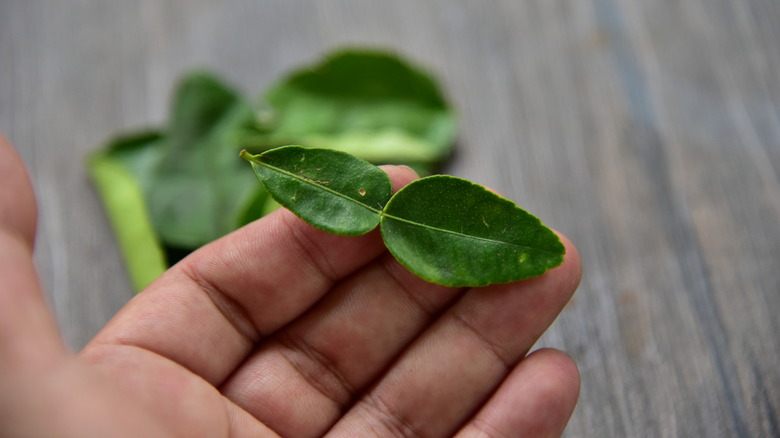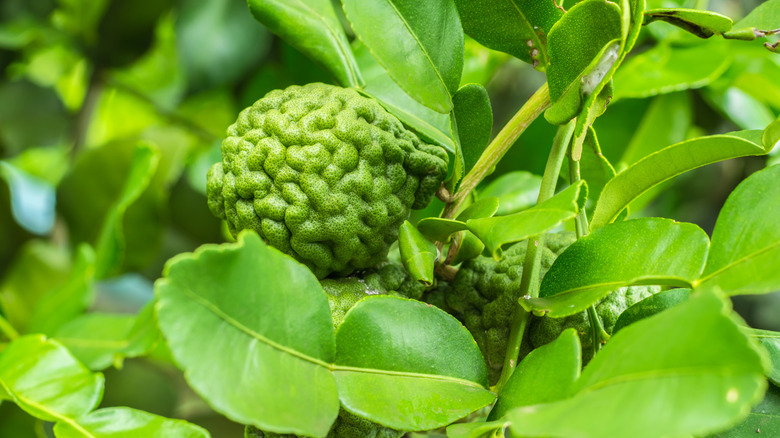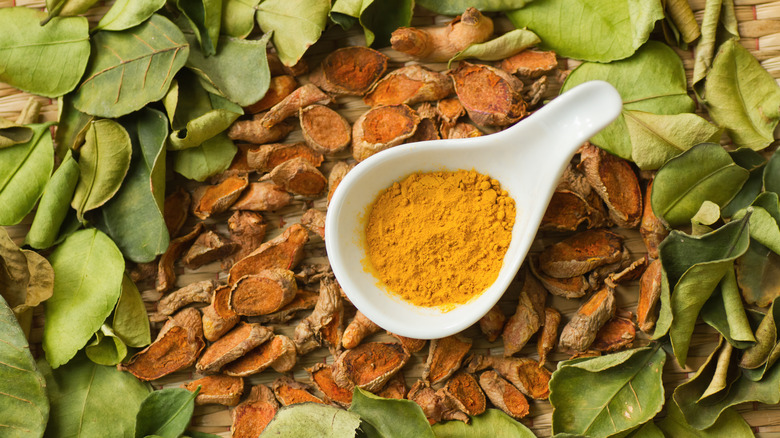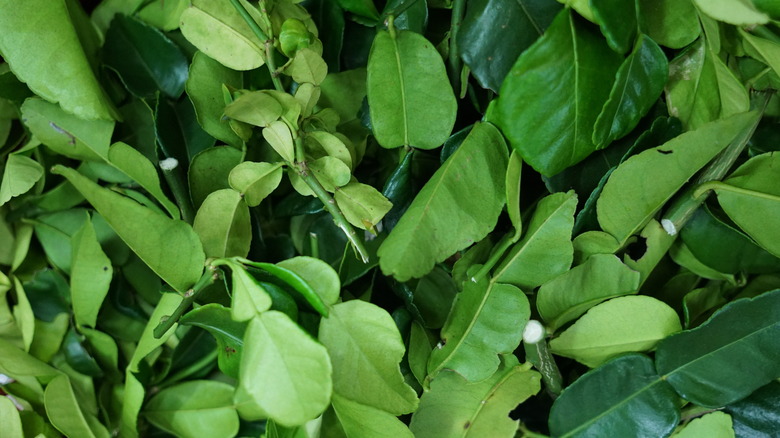What Are Makrut Lime Leaves And How Do You Cook With Them?
We may receive a commission on purchases made from links.
Pad thai and papaya salad are infamous examples of Thai food, yet they're only a tiny snippet of a complex, varied cuisine. From the spicy, bold curries of southern Thailand to the herbal, vegetable-driven dishes of the north (via Culture Trip), it's hard to encapsulate Thai food into a single entity.
However, some pantry staples unite all the styles — fish sauce, coriander seeds, garlic, ginger, and aromatics like lemongrass and makrut lime leaves, via Serious Eats. Especially the latter — the deep green makrut lime leaves contribute an unmistakably citrusy, earthy flavor. Balancing other components with a strong zest, their brightness is an essential component of Thai cuisine. Also making frequent appearances in Laotian, Vietnamese, and Indonesian food, it's safe to say the food punches far above its weight, notes Thai Food Online. So let's dive into this herbal ingredient and how to cook with it — its flavor is unlike anything else.
What are makrut lime leaves?
Makrut limes, also referred to as Thai limes or kaffir limes, are a thorny plant in the citrus family (via Tyrant Farms). Although kaffir lime is the most used name for the plant in the Western Hemisphere, it's a racial slur in South Africa. As a result, avoid the term– no need to utilize discriminatory language to name a lime (via Modern Farmer).
Makrut is most famous for its leaves, which boast a delightfully bright, citrusy aroma with an herbal lime-like flavor. Kind of like a bay leaf, they're typically added whole, then discarded. The plant's flowers are also edible — frequently made into tea. The fruit itself is much more potent than a Persian-style lime — just a little juice can overpower other flavors. Not only highly acidic, but the juice flavor can also sometimes be unpalatable and soap-like, per Tyrant Farms.
According to The Guardian, the aromatic lime leaves aren't easy to farm — hence why they fetch some high prices. It takes four years for the plant to mature, and the leaves are picked by hand, a task made extra strenuous by thorny branches. However, the efforts are worthwhile, with only a handful of leaves generating a complex taste.
How to cook with makrut lime leaves
Although much weaker in flavor than the whole fruit, less is more when it comes to makrut lime leaves. Their strong essence is imparted from cut-up fresh strips, pastes, and spice mixes. A staple in curries, soups, and stir-fries, whole leaves can also be used to infuse into the dishes' flavor via Fruitstand.
It's helpful to remove the stem before cooking with the leaf. Simply fold the leaf in half and then rip out the limb, or use a paring knife for help. Afterward, add the leaves to the dish, making sure to discard them before serving. Often sold frozen, no additional prep work is necessary when using cold makrut leaves. However, with the dried variant, rehydrate or crush into a powder — accounting for the dried leaf's decreased potency, reports The Spruce Eats.
Combined with lemongrass, ginger, and often galangal, shallots, and chilies, makrut lime leaf forms a commonplace Thai base — used as a starting point for many dishes. In addition to traditional uses, consider makrut leaves for infusions, whether in pickling, curing, or a salt form, notes Great British Chefs.
Where to buy and how to store makrut lime leaves
Makrut lime leaves can be purchased at Asian grocery stores, especially with a Thai, Vietnamese, and sometimes Chinese focus. Look for the leaf in the herb section, in the freezer, or alongside other spices. They're also sold online, but verify the vendor so the delivered batch is fresh. For a homegrown variant, consider purchasing a makrut lime tree — it'll grow outside in warmer climates, or make for a pleasant indoor plant, notes U.S. Citrus.
The leaves store well — retaining freshness for around a week in the fridge. For prolonged storage, freeze the leaves in a plastic bag. They'll never spoil in this form, although flavor will diminish after a year, per Twisted Citrus. If unable to find the leaf, simply leave it out of the recipe. Unfortunately, there is no alternative; the flavor is unique and irreplicable, notes The Spruce Eats. All the more impetus to grab a batch when spotted — incredibly flavorful, bright, and aromatic, there's nothing quite like the delectable makrut lime leaf.



